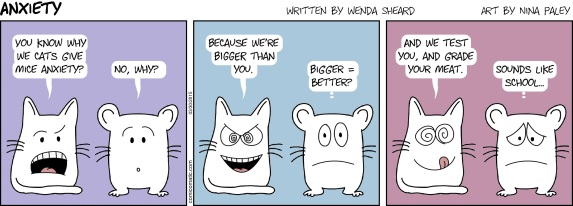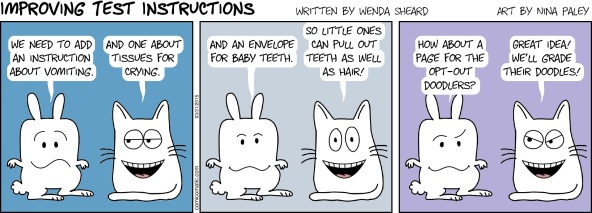Childhood Anxiety from Adult Shenanigans
Posted: April 1, 2015 Filed under: Uncategorized | Tags: anxiety, common core, standardized testing 9 CommentsWhat exactly is anxiety? A beast that consumes children? A mental disorder listed in the American Psychiatric Association’s latest controversial version of the Diagnostic and Statistical Manual of Mental Disorders (DSM5)?
The Merriam-Webster Learner’s Dictionary says anxiety is “fear or nervousness about what might happen.” For millennia children have been afraid of imaginary monsters in the dark. Children have wondered, “Will those monsters hurt us? Will they hurt the stuffed animals we love tightly in our arms?” But today I’m not going to talk about the usual childhood fears of monsters under our beds.
Instead, I’m going to talk about even worse childhood fears–those fears scary enough to do damage to children, and scary enough to warrant conference presentations, research dollars, and blog hop articles. Although some anxiety disorders are caused by children, the sad truth is that most anxiety disorders result from adult shenanigans, including family breakdowns, violence, and questionable education policies and practices.
In this article, I focus on anxiety relating to education. In particular, I discuss standardized testing, one-size-fits-all standards, over-emphases on grades, and pressures to attend selective colleges. I offer solutions for conquering education-related childhood anxieties, and I urge children and their adults to disengage from the anxiety-producing trappings of our current education climate.
An Epidemic of Anxiety?
When releasing a May 2013 report on the mental health of children, the U.S. Center for Disease Control wrote, “Based on the National Research Council and Institute of Medicine report (Preventing mental, emotional, and behavioral disorders among young people: progress and possibilities, 2009) that gathered findings from previous studies, it is estimated that 13 –20 percent of children living in the United States (up to 1 out of 5 children) experience a mental disorder in a given year and an estimated $247 billion is spent each year on childhood mental disorders.”
But how many of those 13% to 20% of children suffer from anxiety disorders in a given year? The U.S. National Institute of Mental Health factsheet on anxiety disorders in children and adolescents notes, “A large, national survey of adolescent mental health reported that about 8 percent of teens ages 13-18 have an anxiety disorder, with symptoms commonly emerging around age 6.”
Really, truly? Eight percent of our teens ages 13-18 have diagnosable anxiety disorders? Heavens to mercy!
According to a series of seminars by PESI, Inc., a nonprofit dedicated to providing continuing education to health professionals, we have an emerging epidemic of anxiety disorders in children and adolescents. PESI is currently offering a seminar titled, “Anxiety Disorders in Children and Adolescents: Recognizing & Treating the Emerging Epidemic” to professionals in 53 locations around the United States.
The description of the PESI seminar says, “The increasing rate of stress and trauma to children, which includes divorce, family breakdown, violence in society, the media, and failing school system, has produced a ”shell shocked” generation suffering from anxiety in many cases.” Notice that the PESI description includes “failing school system” as a cause of the emerging anxiety epidemic.
Scientists are finding that anxiety is not without biological correlates. The U.S. National Institute of Mental Health notes, “Imaging studies show that children with anxiety disorders have atypical activity in specific brain areas, compared with other people.” The atypical activity occurs in brain structures related to fear and emotion. But why are more children fearful and scared these days?
Adult Shenanigans
 Let’s go back to the PESI list of causes of anxiety disorders among children: “stress and trauma to children, which includes divorce, family breakdown, violence in society, the media, and failing school system.” How many of those items involve adults?
Let’s go back to the PESI list of causes of anxiety disorders among children: “stress and trauma to children, which includes divorce, family breakdown, violence in society, the media, and failing school system.” How many of those items involve adults?
Last I checked, divorce is an adult thing. Except in cases of sibling misbehavior, family breakdown is usually an adult thing. Yes, children commit violent acts sometimes, but the majority of offenders are adults. I don’t know of any children who work in media outlets, except perhaps young actors who have little say about the dramas they perform and young newspaper carriers who have little say about the content of the newspapers they carry. And the failing school system? How often do children control their schools?
Without a doubt, the vast majority of childhood anxiety disorders result from adult behaviors. (See, also, the comments from poprice, below, reminding us about genetic and environmental causes of anxiety disorders.) I’ll let others write about anxiety caused by divorce and violence. For this article, I focus on education-related causes of childhood anxiety.
Education-Related Causes of Childhood Anxiety
Whose bright idea was it to sit children in chairs and desks for hours at a time, many days during the school year, forcing them to answer questions designed by national and multinational corporations to measure the performance of teachers and schools?
A particular child has difficulty focusing for long periods of time? Give that child an even longer period of time to complete the standardized test. Another child has a cognitive disability so severe that everyone knows the child can’t possibly pass the test? Make the child take the test anyway. Worried about the tests interrupting school’s normal schedule for weeks and months at a stretch? Stay calm and carry on.
Imagine how children who are living in the standardized testing shadows of No Child Left Behind are feeling this year. Even first graders are taking state-mandated tests. Little first graders, some with all their baby teeth intact. According to one media report, teachers say that some young children have thrown up and cried during standardized testing.
And whose bright idea was it to create a Common Core State Standards aimed at all children in the nation? Although I’m happy to see some of the challenging Common Core State Standards for Mathematics that require teachers and students to think hard about mathematical concepts, I’m scratching my head about how adults who participated in the creation of the standards could think it’s ok to expect all children of a certain age to learn the same thing at the same time.
For instance, the Common Core State Standards website includes a two-page document about applying the standards to children with disabilities. Witness this last paragraph of that document:
Some students with the most significant cognitive disabilities will require substantial supports and accommodations to have meaningful access to certain standards in both instruction and assessment, based on their communication and academic needs. These supports and accommodations should ensure that students receive access to multiple means of learning and opportunities to demonstrate knowledge, but retain the rigor and high expectations of the Common Core State Standards.
Wow. I had to read that twice. Does the paragraph really advise educators to apply the same “rigor and high expectations” to all children, even those with the most significant cognitive disabilities? Do you think some children with the most significant cognitive disabilities might feel anxiety as a result?
And what about children who are functioning intellectually one or two or more grade levels ahead of their age mates? Why are the Common Core State Standards presumed to apply to all students, when some students are ready and eager for higher standards? I thought we were in the 21st Century, complete with technology available to help individualize various aspects of education for those in need of individualization. I thought we had sufficient common sense and brain research to know that different children have different minds.
 Policy-makers are not the only guilty parties in our current anxiety-provoking education climate. During my years of teaching middle school and high school, I met many students who were afraid to show their parents low quiz scores. Some high achieving students felt that anything less than a top grade would result in significant parental disapproval. A few parents felt so strongly about their children’s school grades that the parents argued about the grades not only with their children, but also with their children’s teachers. Those parents obviously cared deeply about their children and their children’s futures–but cared too deeply and cared in anxiety-producing directions.
Policy-makers are not the only guilty parties in our current anxiety-provoking education climate. During my years of teaching middle school and high school, I met many students who were afraid to show their parents low quiz scores. Some high achieving students felt that anything less than a top grade would result in significant parental disapproval. A few parents felt so strongly about their children’s school grades that the parents argued about the grades not only with their children, but also with their children’s teachers. Those parents obviously cared deeply about their children and their children’s futures–but cared too deeply and cared in anxiety-producing directions.
Talk to any college counselor in a high school serving a majority college-going student body. Ask about “those parents”–the ones who refuse to accept the college counselor’s recommendations regarding which colleges will likely accept the student and where the student might fit best during the college years. Or ask about the parents who act as though they themselves are the ones applying to college. How do those parents’ hyper-involved actions and attitudes make their children feel? Do you think the parents’ anxieties might rub off on their children?
Anxiety Solutions
What can adults do to prevent anxiety among children besides staying happily married, refraining from violence, and accepting the advice of college counselors? Here’s a list of education-related solutions.
1. If the curricula in your child’s school do not match the level and speed of your child’s learning, advocate for change. If change isn’t imminent, help your child understand that school is not as high and mighty as teachers and parents sometimes appear to believe. Sometimes it’s ok to smile at the bird outside the classroom window even if you’re failing a quiz or sitting through a lesson you already know. Give your child permission to enjoy life despite policy and economic failures to provide all children with ideal educations.
2. Tell your child that lots of important learning happens outside of school, and outside the confines of lessons that teachers plan for the entire class. Tell your child that teachers are sometimes willing to allow children to suggest interest-based or passion-based embellishments to assignments and projects. Encourage your child to express interests and passions, and to ask for permission to embellish assignments and projects.
3. Consider opting your child out of standardized testing. Even if your child doesn’t suffer anxiety as a result of taking a standardized test, the overall testing burden is so onerous in U.S. public schools that we all ought to consider joining the fast-growing opt out movement. For more information, see any number of the dozens of Facebook pages and websites from around the United States with titles such as Opt Out, Refuse the Test, and Badass Teachers Association. One milestone this week: New York State United Teachers president Karen Magee urged parents to opt their children out of standardized tests.
4. De-emphasize grades. Convince your child that your love is unconditional, not based on report card grades. Tell your child that millions of successful people have received poor grades in school now and then. If your child hopes to attend college, show your child that there are colleges in our country, particularly community colleges, that accept students with below average high school grades and prepare those students for worthy careers or for transfer to four-year colleges.
 6. Spend time with your child. Let your child know the worries and fears you experienced when you were growing up. Compare and analyze worries and fears. Read and discuss the suggestions in Dealing with Child Anxiety? 9 Things You Can Try. Talk about the benefits of focusing our minds on happy thoughts and experiences most of the time.
6. Spend time with your child. Let your child know the worries and fears you experienced when you were growing up. Compare and analyze worries and fears. Read and discuss the suggestions in Dealing with Child Anxiety? 9 Things You Can Try. Talk about the benefits of focusing our minds on happy thoughts and experiences most of the time.
7. Find people with whom your child enjoys spending time and then spend time with those people. Do your best to pay attention to all aspects of your child’s being, including the social, emotional, physical, and spiritual aspects. Do not limit your child’s friend choices to same-age friends; friends can come in all ages as well as all sizes, shapes, colors, and religions. When we have friends, we have less time for fears.
8. If your child is truly suffering from anxiety, seek out counseling. According to the U.S. National Institute of Health, the Child/Adolescent Anxiety Multimodal Study (CAMS) published in 2010 found that high-quality cognitive behavioral therapy has shown promise in helping children with anxiety disorders.
9. For the benefit of all children in your school district, consider advocating for a grading system similar to one that includes only two grades choices–an “A’ or a “Not Yet.” Advocate that children should be able to learn at their own speeds, without putting forth anxiety-producing degrees of effort. All children are entitled to learn in a manner compatible with good mental health.
10. Advocate for local control and equitable funding of public schools. Much of the anxiety-producing parts of today’s schools results from standards imposed by policy makers far away. No one knows a local community better than the residents who live there. Let state and local communities decide what educational standards and assessments are right for the children in their schools given the local political, cultural, economic, and social climate.
Conclusion
When a child suffers from anxiety despite our best efforts, let’s do whatever possible to disengage the child from the negative effects of the anxiety. When education is the source of the child’s anxiety, let’s consider telling the child about the failings of adults involved in education policy decisions. Let’s also consider giving the child permission to disengage from whatever elements of education might be causing the child undue pain.
With courageous parental support, children who earn an “F” on a test or quiz due to factors beyond their reasonable control might feel as though they have earned an “A'” in taking care of their mental health. Our children deserve no less than our best efforts to preserve their happy childhoods as we prepare them for the adult world.
From Comments From Elsewhere:
Thanks to Kristin Humbarger for sharing The Neuroscience of Anxiety Disorders with me and others with similar interests.
Acknowledgements and Credits
This blog article is part of the Hoagies’ Gifted Education Page April 2015 Blog Hop on Anxiety. I thank my friends at Hoagies’ Gifted Education Page and elsewhere for their inspiration, support, and suggestions.
I created the comics via the Comic-O-Matic website of Nina Paley and Margo Burns. (Thanks!)
The photographs are my own, taken in 2014 in Athens, Ohio, except for the forest photo, which I took at last summer at Camp Copneconic outside of Fenton, Michigan.
Please click on the graphic below (created by Pamela S Ryan–thanks!) to see the titles, blog names, and links of other Hoagies Blog Hop participants.





Recent Comments